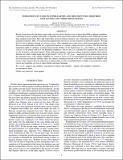FORMATION OF CLOSE IN SUPER-EARTHS AND MINI-NEPTUNES: REQUIRED DISK MASSES AND THEIR IMPLICATIONS
Author(s)
Schlichting, Hilke E
DownloadSchlichting-2014-Formation of close i.pdf (511.4Kb)
PUBLISHER_POLICY
Publisher Policy
Article is made available in accordance with the publisher's policy and may be subject to US copyright law. Please refer to the publisher's site for terms of use.
Terms of use
Metadata
Show full item recordAbstract
Recent observations by the Kepler space telescope have led to the discovery of more than 4000 exoplanet candidates consisting of many systems with Earth- to Neptune-sized objects that reside well inside the orbit of Mercury around their respective host stars. How and where these close-in planets formed is one of the major unanswered questions in planet formation. Here, we calculate the required disk masses for in situ formation of the Kepler planets. We find that if close-in planets formed as isolation masses, then standard gas-to-dust ratios yield corresponding gas disks that are gravitationally unstable for a significant fraction of systems, ruling out such a scenario. We show that the maximum width of a planet's accretion region in the absence of any migration is 2v [subscript esc]/Ω, where v [subscript esc] is the escape velocity of the planet and Ω is the Keplerian frequency, and we use it to calculate the required disk masses for in situ formation with giant impacts. Even with giant impacts, formation without migration requires disk surface densities in solids at semi-major axes of less than 0.1 AU of 10[superscript 3]-10[superscript 5] g cm[superscript –2], implying typical enhancements above the minimum-mass solar nebular (MMSN) by at least a factor of 20. Corresponding gas disks are below but not far from the gravitational stability limit. In contrast, formation beyond a few AU is consistent with MMSN disk masses. This suggests that the migration of either solids or fully assembled planets is likely to have played a major role in the formation of close-in super-Earths and mini-Neptunes.
Date issued
2014-10Department
Massachusetts Institute of Technology. Department of Earth, Atmospheric, and Planetary SciencesJournal
The Astrophysical Journal. Letters
Publisher
IOP Publishing
Citation
Schlichting, Hilke E. “FORMATION OF CLOSE IN SUPER-EARTHS AND MINI-NEPTUNES: REQUIRED DISK MASSES AND THEIR IMPLICATIONS.” The Astrophysical Journal 795, no. 1 (October 16, 2014): L15. © 2014 The American Astronomical Society
Version: Final published version
ISSN
2041-8213
2041-8205